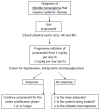Cardiovascular drugs in the treatment of infantile hemangioma
- PMID: 26839658
- PMCID: PMC4728108
- DOI: 10.4330/wjc.v8.i1.74
Cardiovascular drugs in the treatment of infantile hemangioma
Abstract
Since the introduction of propranolol in the treatment of complicated infantile hemangiomas (IH) in 2008, other different beta-blockers, including timolol, acetabutolol, nadolol and atenolol, have been successfully used for the same purpose. Various hypotheses including vasoconstriction, inhibition of angiogenesis and the induction of apoptosis in proliferating endothelial cells have been advanced as the potential beta-blocker-induced effect on the accelerated IH involution, although the exact mechanism of action of beta-blockers remains unknown. This has generated an extraordinary interest in IH research and has led to the discovery of the role of the renin-angiotensin system (RAS) in the biology of IH, providing a plausible explanation for the beta-blocker induced effect on IH involution and the development of new potential indications for RAS drugs such as angiotensin-converting enzyme inhibitors and angiotensin-receptor blockers in the treatment of IH. This review is focused on the current use of cardiovascular drugs in the treatment of IH.
Keywords: Angiogenesis; Beta-blockers; Infantile hemangioma; Renin-angiotensin system.
Figures
Similar articles
-
β-blocker therapy for infantile hemangioma.Expert Rev Clin Pharmacol. 2020 Aug;13(8):899-915. doi: 10.1080/17512433.2020.1788938. Expert Rev Clin Pharmacol. 2020. PMID: 32662682 Review.
-
Biology of infantile hemangioma.Front Surg. 2014 Sep 25;1:38. doi: 10.3389/fsurg.2014.00038. eCollection 2014. Front Surg. 2014. PMID: 25593962 Free PMC article. Review.
-
Serum levels of renin, angiotensin-converting enzyme and angiotensin II in patients treated by surgical excision, propranolol and captopril for problematic proliferating infantile haemangioma.J Plast Reconstr Aesthet Surg. 2016 Mar;69(3):381-6. doi: 10.1016/j.bjps.2015.10.020. Epub 2015 Oct 26. J Plast Reconstr Aesthet Surg. 2016. PMID: 26612192
-
Beta blocker treatment for infantile hemangiomas.Dermatol Online J. 2015 Jul 15;21(7):13030/qt05k4t1hq. Dermatol Online J. 2015. PMID: 26436966 Review.
-
Expression of components of the renin-angiotensin system in proliferating infantile haemangioma may account for the propranolol-induced accelerated involution.J Plast Reconstr Aesthet Surg. 2011 Jun;64(6):759-65. doi: 10.1016/j.bjps.2010.08.039. Epub 2010 Sep 26. J Plast Reconstr Aesthet Surg. 2011. PMID: 20870476
Cited by
-
Cost-effectiveness of atenolol compared to propranolol as first-line treatment of infantile haemangioma: A pilot study.JPRAS Open. 2022 May 26;33:52-56. doi: 10.1016/j.jpra.2022.05.010. eCollection 2022 Sep. JPRAS Open. 2022. PMID: 35784377 Free PMC article.
-
Propranolol induces hemangioma endothelial cell apoptosis via a p53‑BAX mediated pathway.Mol Med Rep. 2018 Jul;18(1):684-694. doi: 10.3892/mmr.2018.9013. Epub 2018 May 14. Mol Med Rep. 2018. PMID: 29767244 Free PMC article.
References
-
- Mulliken JB, Glowacki J. Hemangiomas and vascular malformations in infants and children: a classification based on endothelial characteristics. Plast Reconstr Surg. 1982;69:412–422. - PubMed
-
- Frieden IJ, Eichenfield LF, Esterly NB, Geronemus R, Mallory SB. Guidelines of care for hemangiomas of infancy. American Academy of Dermatology Guidelines/Outcomes Committee. J Am Acad Dermatol. 1997;37:631–637. - PubMed
-
- Enjolras O, Mulliken JB. Vascular tumors and vascular malformations (new issues) Adv Dermatol. 1997;13:375–423. - PubMed
-
- Kilcline C, Frieden IJ. Infantile hemangiomas: how common are they? A systematic review of the medical literature. Pediatr Dermatol. 2008;25:168–173. - PubMed
-
- Léauté-Labrèze C, Dumas de la Roque E, Hubiche T, Boralevi F, Thambo JB, Taïeb A. Propranolol for severe hemangiomas of infancy. N Engl J Med. 2008;358:2649–2651. - PubMed
Publication types
LinkOut - more resources
Full Text Sources
Other Literature Sources


